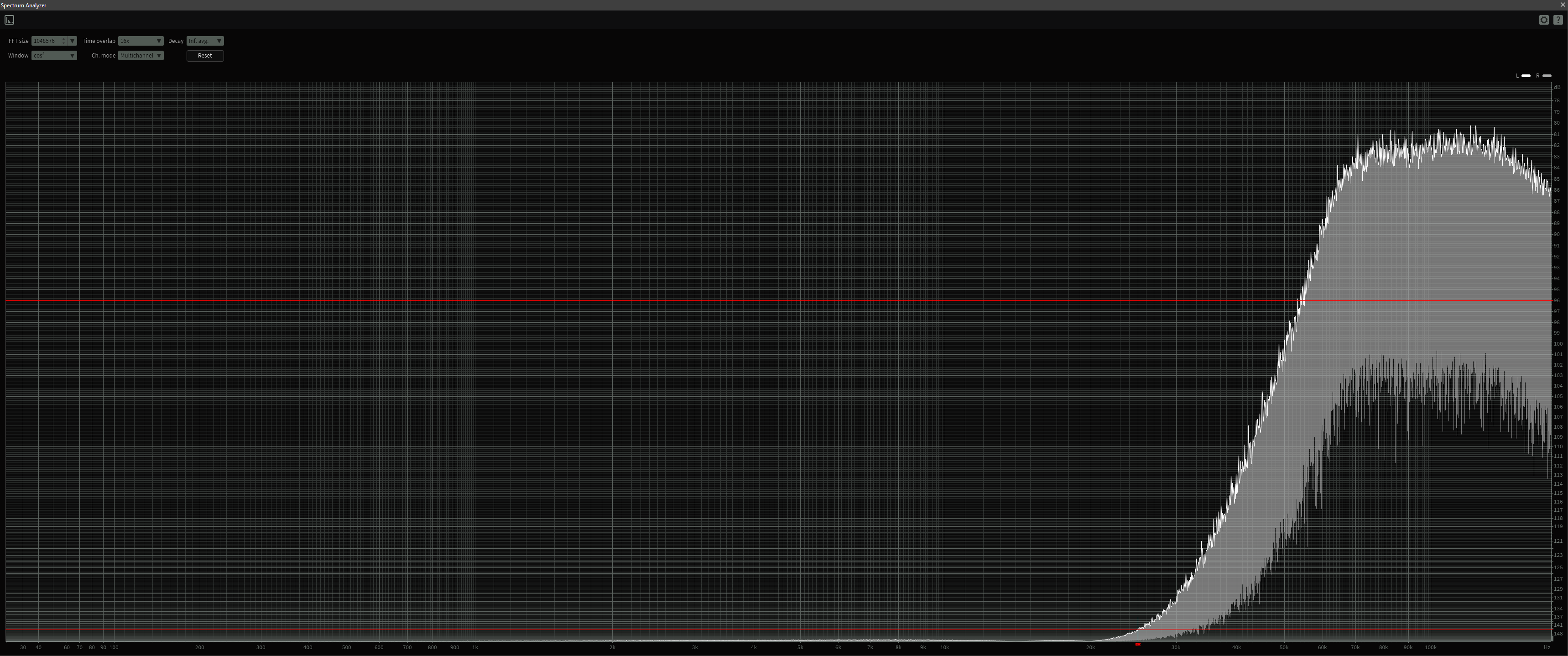I don't think it is quite as clear cut as you seem to believe. One of todays' problems, which makes it increasingly difficult to get to facts on just about any subject is that there are so many people who feel the need to state opinions as facts...
I've read stories from both opponents and proponents of the DSD format. The opponents usually seem quite passionate, but are unfortunately almost always the least informed....though there are exceptions.
As I have said, I am intrigued by the format. I am 51 and my ears won't hear anything above 16KHz... In fact, my ears can't tell the difference between High Res music and CD quality (or even lossy compressed for that matter). This doesn't stop me from enjoying it. It also doesn't cause my inquisitive mind to shut off.
Here's the noise spectrum of an unfiltered DSD track, converted to 352.8kHz PCM:

I've marked -96dB, -144dB, and 25kHz points.
-96dB is the noise floor for
undithered 16-bit PCM.
-144dB is the noise floor for
undithered 24-bit PCM.
25kHz is the point at which the noise floor rises above -144dB.
So if we make a naive comparison, you could say that DSD has lower noise than PCM in the audio band (20-20K), and its frequency response would match approximately 50kHz PCM. (sample rate must be twice your highest frequency to avoid aliasing)
Or if you work in marketing, you would say that DSD's frequency response extends to ~54kHz, since that's approximately where it crosses the -96dB mark, which you could say is approximately 96kHz PCM.
But that is compared to
undithered PCM.
With flat TPDF dithering (well, a 3dB tilt as is typical) the noise floor for 16-bit PCM drops to about -140dB, and 24-bit PCM drops to about -190dB.
With noise shaped TPDF dither, the noise floor for 24-bit PCM drops to below -240dB.
Higher sample rates allow for lower noise in the audio band, since you can shift the noise into even higher frequencies. Here, I used 192kHz.

DSD also has problems with an uneven noise floor. It's not flat like PCM, since there are insufficient bits to fully dither the signal.

While it may be around -190dB or so at the lower end of the spectrum, it rises to about -160dB around 7-8kHz, which puts it somewhere in-between 16-bit and 24-bit PCM if you consider the entire audio band. That's why it's compared to approximately 20-bit PCM.
But this is all unnecessary anyway, because no audio system in existence has a noise floor that low, and even if such a system were to exist, it would be masked by environmental noise anyway.
Not to mention that if you're listening to music so loud that you can hear even a -96dB noise floor from undithered 16-bit playback, you will be deaf in no time.

Using 24-bit in production allows you to record at lower volume levels which means that the audio is far less likely to clip/saturate when things get loud.
For release, the gain will be normalized so that all the audio information is well above -96dB and thus there is no need for 24-bit as a distribution format.
High sample rates are used in production because it means that spurious tones will be sampled correctly instead of causing aliasing, which allows them to be filtered out when converted to a 44.1/48kHz format for release.
If you're buying the high-res tracks, all you're getting is additional noise that is beyond the range of human hearing, which has the possibility of causing aliasing in your playback system - and that
will be audible.
Some of these tracks just have continuous or repeating tones around 30kHz or so, and the rest of it is just noise. If you filter out anything below 20kHz or so, and then pitch-down the high frequency content so that we can hear it, there's nothing of value there.
The reason I have DSD tracks in my library is because they're the only way to get 5.1 mixes for some albums, or because I don't want to buy them again just to get a DVD-A/Blu-ray version of the same thing.

 Author
Topic: Dynamic range DSD vs PCM (Read 10428 times)
Author
Topic: Dynamic range DSD vs PCM (Read 10428 times)

